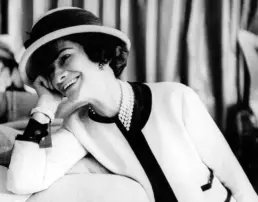These life stories may contain descriptions of childhood trauma and abuse, as well as images, voices and names of people now deceased. If you need help, you can find contact details for some relevant support services on our support page.
French fashion designer Gabrielle (Coco) Chanel (1883-1971) was in an orphanage as a child.
Gabrielle was born into poverty in Saumur, France, the daughter of a “street vendor” (McNeil).
When Gabrielle’s mother, Jeanne Devolle, died in 1895, Gabrielle and her two sisters were taken by their father to an orphanage run by the Congregation of the Sacred Heart of Mary in rural France. It was while living in the orphanage that Gabrielle learned to sew.
Gabrielle left the orphanage at eighteen and went as a scholarship student to a boarding school run by the Sisters of Notre Dame in Moulins, France. While at school she reconnected with members of her father’s family.
Gabrielle became Coco as a cabaret singer when, as a young adult, she was also working as a seamstress and sales assistant in Moulins.
In a forecast of her later work with serial repetition, Chanel used basic templates, such as the boater or wide brimmed straw hats which she dressed very simply. Her work struck a modern note and was popularised by actresses (McNeil).
In 1913 Coco Chanel opened her first shop, a hat shop. By 1919 she had generated publicity in fashion magazines and became famous with her Chanel No. 5 (1921) – from which she “made a fortune” (McNeil) – and little black dress (1926).
Chanel was hugely influential in driving a new direction in women’s fashion that abandoned uncomfortable petticoats and corsets in favour of an elegant, yet comfortable way of dressing.
Concerns about Chanel’s involvement with the Nazis during the Second World War saw her leaving France for Lausanne, Switzerland. She returned in 1954 and “surprised everyone with the famous two piece Chanel suit, worn with a co-ordinating blouse.”
The Gabrielle Chanel Fashion Manifesto, held at the NGV International, Melbourne between 4 December and 25 April 2022, is the first exhibition in Australia to focus solely on Chanel’s work.
References
“Coco Chanel.” Britannica. https://www.britannica.com/biography/Coco-Chanel
McNeil, Peter. “Friday essay: Chanel’s complex legacy.” The Conversation, 10 December 2021. https://theconversation.com/friday-essay-chanels-complex-legacy-172761
Image available here.
